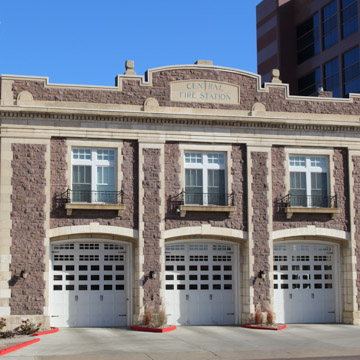You are here
Central Fire Station
One of the oldest working fire stations west of the Mississippi River, and among the oldest extant buildings in downtown Sioux Falls, the Central Fire Station was designed by local architect Joseph Schwarz to accommodate horse-drawn fire equipment. After a massive fire destroyed the four-story Cataract Hotel (1884, Wallace Dow; 1889 addition) in 1900, Sioux Falls established its city fire department; prior to that, the city’s firefighters were volunteers.
The two-story building is constructed of locally quarried, rusticated Sioux quartzite with concrete quoins, window trim, cornices, and parapet edges. A central parapet wall features a concrete sign inscribed with “Central Fire Station” and is flanked by raised concrete urns. The main facade is dominated by three fire bays that originally contained double doors but have since been replaced with modern overhead doors in a style compatible with the building. On the north side of the building is a one-story wing and a sixty-five-foot bell tower used to drain and store the fire hoses.
The main floor originally contained a large apparatus area and horse stalls; the hayloft and oat bins were directly above the stalls to maximize space. Across the front of the building on the second floor are the sleeping quarters, where three brass sliding rails connect to the main level for quick response to fire calls. Also on the second floor is an office, gymnasium, bathroom, and reception and lounge areas. The building has a full basement with ample storage space and, like the main level, has a concrete floor. In 1917, when motorized equipment replaced the horses, the interior was remodeled to remove the horse stalls. Due to structural weakness in the tower, the bell was removed in 1957.
The building was fully restored in 2015.
References
Writing Credits
If SAH Archipedia has been useful to you, please consider supporting it.
SAH Archipedia tells the story of the United States through its buildings, landscapes, and cities. This freely available resource empowers the public with authoritative knowledge that deepens their understanding and appreciation of the built environment. But the Society of Architectural Historians, which created SAH Archipedia with University of Virginia Press, needs your support to maintain the high-caliber research, writing, photography, cartography, editing, design, and programming that make SAH Archipedia a trusted online resource available to all who value the history of place, heritage tourism, and learning.














